The Strong Museum of Play in Rochester, New York, has been operating since 1969. Originally based on the personal collection of Margaret Woodbury Strong with more of a focus on the area of New York state where it’s situated, the museum now centres its mission to explore “play and the ways in which it encourages learning, creativity, and discovery and illuminates cultural history.” I had heard about the Strong via colleagues at the museum I work at here in Toronto, and thought visiting its treasures would make a fantastic field trip with some like-minded folks during the Gathering of Friends this year.
About 15 of us made our way to the Strong and were treated to a 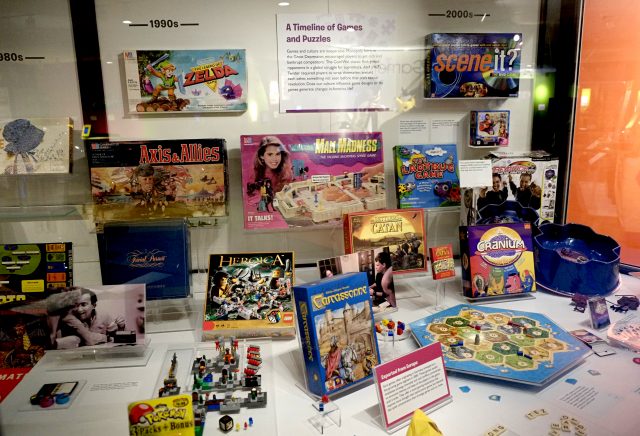 behind-the-scenes look at the board game collections & archives as well as visiting the exhibition “Game Time!” about the history of games. The museum also has collections and exhibitions related to toys, video games and play in general. Our first stop was to the board game collection storage area, with curator Nicolas Ricketts. As many gamers know, collecting board games can be quite a challenge for space reasons – we first toured through a larger collection area in which some of the board game collection shares space with toys and games, as this had been an expanded storage space added to cope with an ever-growing collection.
behind-the-scenes look at the board game collections & archives as well as visiting the exhibition “Game Time!” about the history of games. The museum also has collections and exhibitions related to toys, video games and play in general. Our first stop was to the board game collection storage area, with curator Nicolas Ricketts. As many gamers know, collecting board games can be quite a challenge for space reasons – we first toured through a larger collection area in which some of the board game collection shares space with toys and games, as this had been an expanded storage space added to cope with an ever-growing collection.
One such influx was a range of games from a donor in California a while ago – in addition, the curatorial team are working their way 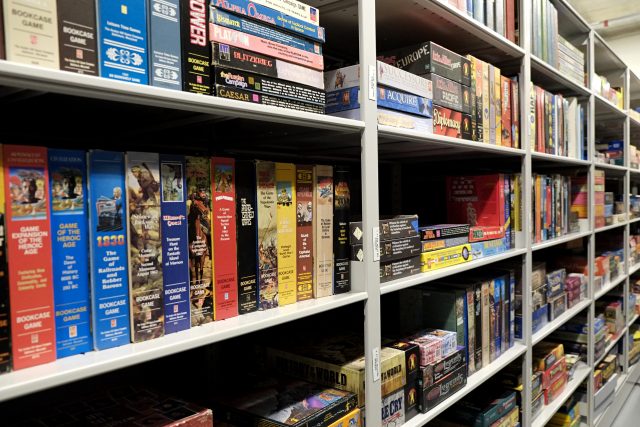 through incoming pallets of games that were part of a donation from an estate. Herein lies the double-edged sword of the museum’s existence: donations of amazing personal collections is ideal, and will enrich the breadth of coverage in the holdings, but it takes an enormous about of people power to get everything catalogued and stored (if you have the space!). But, the Strong are getting there – and while we looked longingly at one of the aforementioned pallets ready to be unpacked, we got to see plenty of the newer acquisitions.
through incoming pallets of games that were part of a donation from an estate. Herein lies the double-edged sword of the museum’s existence: donations of amazing personal collections is ideal, and will enrich the breadth of coverage in the holdings, but it takes an enormous about of people power to get everything catalogued and stored (if you have the space!). But, the Strong are getting there – and while we looked longingly at one of the aforementioned pallets ready to be unpacked, we got to see plenty of the newer acquisitions.
I was blown away by the range of titles I’d not heard of before – rows of bookshelf titles from 3M/Avalon Hill that I definitely didn’t  recognize, as well as a massive selection of war games, and some TSR titles like Marvel Super Heroes and the Dungeons & Dragons Basic and Advanced sets. Sidling down one of the aisles of shelves I hit upon a stack of older, German language versions of Settlers of Catan & expansions – while a lot of us store our games vertically, as does the Strong in some cases, there are many space constraints that mean a number of items are stacked on top of each other, like these copies of Settlers. It can pose a challenge to maintain the condition of games, but the Strong’s curatorial and conservation team are seasoned at making sure everything is stored well. Acid free tissue paper barriers, stronger and sturdier large dividers to prevent contact between boxes, and the like, mean that games will sit well even stacked vertically.
recognize, as well as a massive selection of war games, and some TSR titles like Marvel Super Heroes and the Dungeons & Dragons Basic and Advanced sets. Sidling down one of the aisles of shelves I hit upon a stack of older, German language versions of Settlers of Catan & expansions – while a lot of us store our games vertically, as does the Strong in some cases, there are many space constraints that mean a number of items are stacked on top of each other, like these copies of Settlers. It can pose a challenge to maintain the condition of games, but the Strong’s curatorial and conservation team are seasoned at making sure everything is stored well. Acid free tissue paper barriers, stronger and sturdier large dividers to prevent contact between boxes, and the like, mean that games will sit well even stacked vertically.
After moving on from the Settlers stack, I came upon areas of great nostalgia – titles from the 80s and 90s that aren’t seen in many personal collections now. Milton Bradley’s Jurassic Park game, Thunder Road, Strat-o-Matic sports games, video game titles like Pac-Man and Sonic the Hedgehog, and even an old Parker version of Escape from Colditz. After seeing these fantastic shelves full of variety (the museum’s collection overall is a paragon of variety with the breadth of holdings it has) we moved into the smaller, game-only storage area. I started to spot little pockets of shelves of multiple copies of the same game title; a dozen or so Clue here, a half dozen Life here, and the like.
There’s not many of us in the hobby that will tend toward collecting 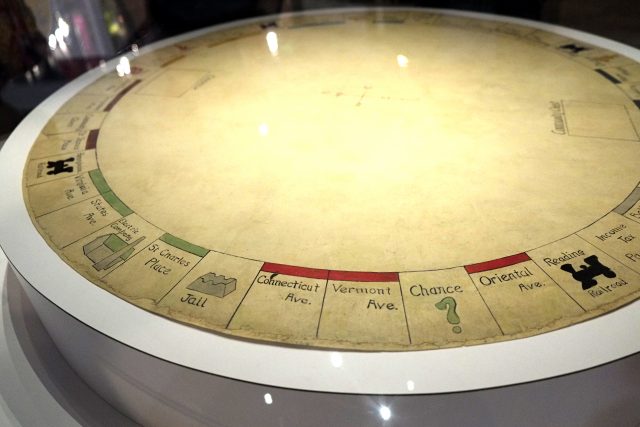 multiple copies/versions of a particular title, but the reason for a museum collection like the Strong to do so is an important one – tracking the changes of not just the game itself over time, but trends overall in play and gaming can be gleaned by looking at the versions throughout the years. The addition or removal of aspects of games can be quite telling regarding their development, markets and the way people play – and seeing all sorts of themes on these games was interesting. Junior versions, VCR games, the dog version of Life, and oh – oh! – the bevy of ‘opoly. Man, did I wanna take a look at Medical Monopoly. As well as these classics and their various iterations, newer games like Say Anything!, Carcassonne, Apples to Apples & Cranium have spots in the collection – representative of the move forward into modern gaming.
multiple copies/versions of a particular title, but the reason for a museum collection like the Strong to do so is an important one – tracking the changes of not just the game itself over time, but trends overall in play and gaming can be gleaned by looking at the versions throughout the years. The addition or removal of aspects of games can be quite telling regarding their development, markets and the way people play – and seeing all sorts of themes on these games was interesting. Junior versions, VCR games, the dog version of Life, and oh – oh! – the bevy of ‘opoly. Man, did I wanna take a look at Medical Monopoly. As well as these classics and their various iterations, newer games like Say Anything!, Carcassonne, Apples to Apples & Cranium have spots in the collection – representative of the move forward into modern gaming.
One of our last stops in the collection storage area was a space holding a great many of classic designer Sid Sackson’s prototypes. With boards and bits and notes all together, it looks like quite a  different area than the rest of the collection’s shelves of published games. Not much is in boxes, and everything is a pretty amazing window into that time of game design. What delighted me most of all was how Sackson had used boards from other games and pasted on hand-drawn maps/layouts of his own, or even created wooden, hand-drilled boards for other games. Board game designers are makers, have always been – and it’s so cool to see this transforming nowadays with newer technologies like 3D printing to keep in the same spirit. There’s also a great chunk of Sackson’s published games nearby in storage, as an interesting comparison to the bare boards and in-progress designs.
different area than the rest of the collection’s shelves of published games. Not much is in boxes, and everything is a pretty amazing window into that time of game design. What delighted me most of all was how Sackson had used boards from other games and pasted on hand-drawn maps/layouts of his own, or even created wooden, hand-drilled boards for other games. Board game designers are makers, have always been – and it’s so cool to see this transforming nowadays with newer technologies like 3D printing to keep in the same spirit. There’s also a great chunk of Sackson’s published games nearby in storage, as an interesting comparison to the bare boards and in-progress designs.
Next up we made our way to the museum’s Brian Sutton-Smith Library and Archives of Play. The library has a vast range of holdings 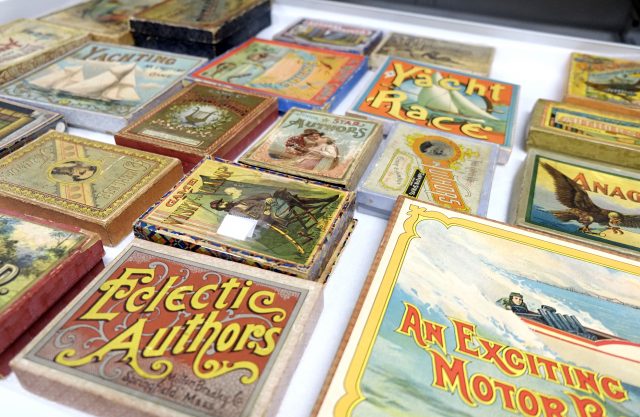 from children’s literature to gaming magazines and toy catalogues, along with academic journals like the Strong’s publication, American Journal of Play. We got to see the back-of house storage and the rows after rows of books and magazines, and some fantastic pieces pulled out like older toy catalogues and the like. The Archives also has extensive holdings related to games and game design, a selection of which was out for us to examine.
from children’s literature to gaming magazines and toy catalogues, along with academic journals like the Strong’s publication, American Journal of Play. We got to see the back-of house storage and the rows after rows of books and magazines, and some fantastic pieces pulled out like older toy catalogues and the like. The Archives also has extensive holdings related to games and game design, a selection of which was out for us to examine.
It was a surprise to see some hand-drawn RPG campaign maps, and I learnt there is a whole archive of these things (The Play Generated Map & Document Archive) and what we saw was a very small example! As well, old, typewritten letters and notes about game design like Clue and Simon were incredible to see, as most of us come to these games knowing them fully formed, and not much about even their first iterations let alone notes that led to their creation. The archives also hold a great deal of content related to Sid Sackson, including his diaries and much correspondence from his designing years. Visitors are able to make appointments to see this content, as well as being able to view comprehensive info & contents listings online beforehand.
We were let loose into the main museum after these exciting adventures, and made a beeline for the “Game Time!” exhibit. As well as fun oversized games and interactives, there’s a timeline of 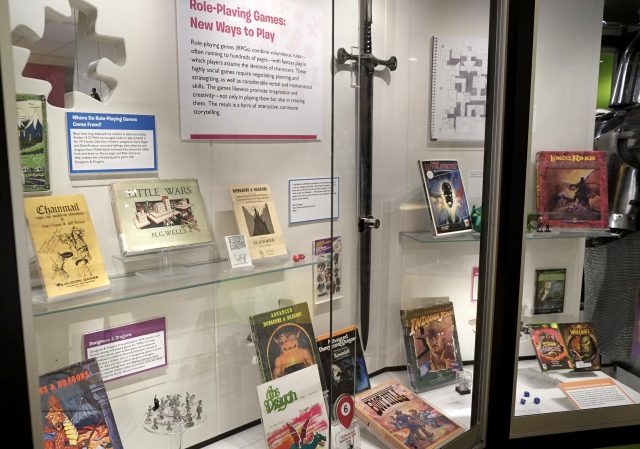 games looking at the past three centuries of board, card, and roleplaying games, and their development. There are some fantastic items on display, including a case of RPGs with some examples of Dungeons & Dragons and many others, an original round Monopoly board, as well as a decade-by-decade look at games that is quite a trip through the history of analog games. I spotted some nostalgic gems in the 80s/90s portion that I hadn’t seen copies of in the collections, and the fully set up Dark Tower game was a sight to behold! And because I’m truly a big kid at heart, I had a great time wandering the exhibition halls in the rest of the museum – seeing the Sesame Street steps, shopping at a miniature Wegman’s and spending a few too many tokens on all the great arcade games were a great deal of fun.
games looking at the past three centuries of board, card, and roleplaying games, and their development. There are some fantastic items on display, including a case of RPGs with some examples of Dungeons & Dragons and many others, an original round Monopoly board, as well as a decade-by-decade look at games that is quite a trip through the history of analog games. I spotted some nostalgic gems in the 80s/90s portion that I hadn’t seen copies of in the collections, and the fully set up Dark Tower game was a sight to behold! And because I’m truly a big kid at heart, I had a great time wandering the exhibition halls in the rest of the museum – seeing the Sesame Street steps, shopping at a miniature Wegman’s and spending a few too many tokens on all the great arcade games were a great deal of fun.
If you are interested at all in play, games and the like, I can’t recommend the Strong Museum enough! There is quite a bit to see in the galleries, and it’s an ideal spot to visit with friends or family, or on your own to hog all the arcade tokens! I think I’ll try to make it down for another visit at next year’s Gathering, but until then I’m still basking in the unique experience we were able to have.
—-
Special thanks to Dan Blum for putting me in touch with folks at the Strong Museum, and to the great staff at the Strong for showing us around – Nic Ricketts, Julia Novakovic & the archives staff.
Living in Ohio I miss Wegman’s. Even tiny Play Wegman’s.
Tiny Play Wegman’s is so charming!
[…] Keep calm and play on Ever heard of the Strong Museum of Play in Rochester, NY? The Daily Worker Placement got a behind-the-scenes tour of this one-of-a-kind institution devoted to fostering cultural creativity, learning and discovery through – among other things – the history of children, play, toys and games. Source: http://dailyworkerplacement.com/2017/04/28/the-strong-museum-of-play/ […]